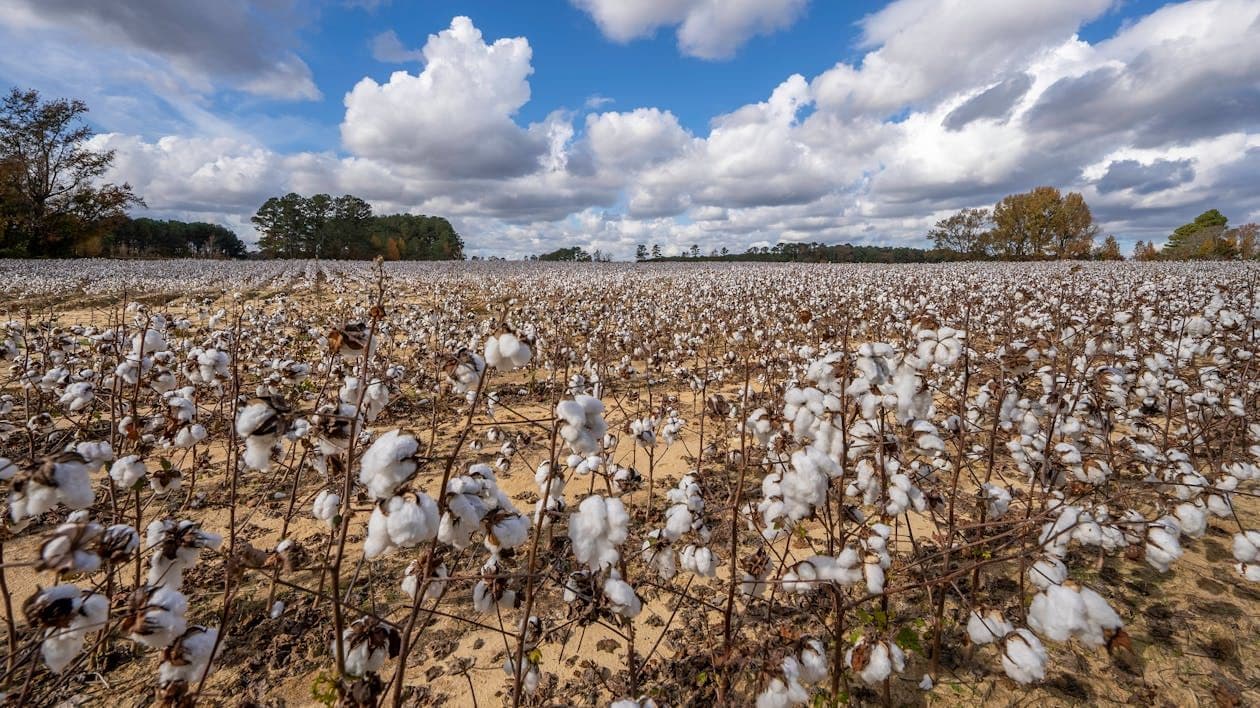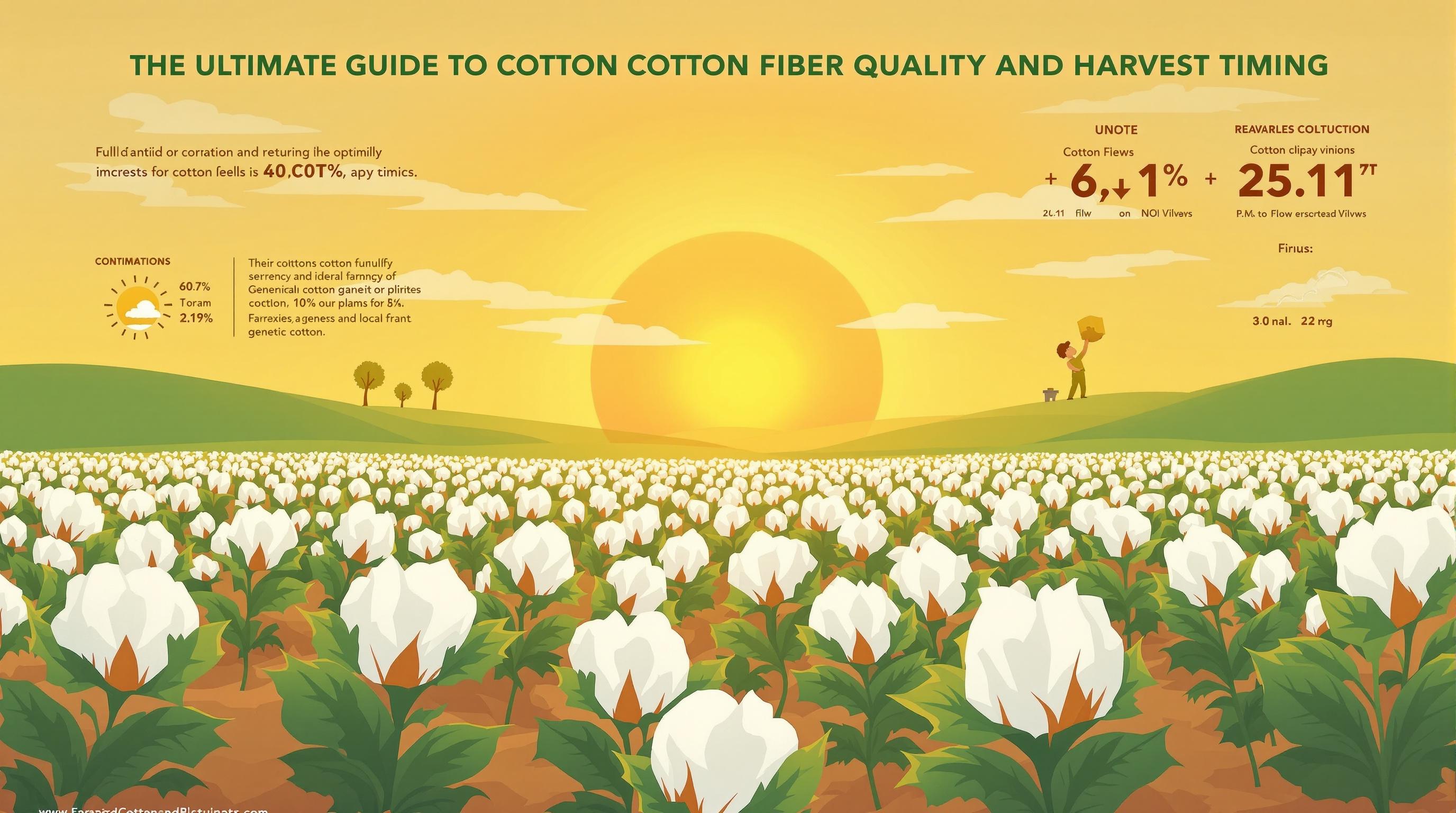Executive summary (TL;DR)
- Scout for 60% open bolls before defoliating cotton—mix thidiazuron with ethephon at 0.75 lb/ai for even leaf drop without stickiness in humid fields.
- Apply harvest aids at 200-250 DD60s post-cutout; use boll slicer checks to confirm maturity and avoid green bolls that slash picker efficiency.
- Tank-mix paraquat for regrowth control in weedy spots—boosts gin turnout 2-5% by cleaning up vines and improving module quality.
Related Post: For broader end-of-season tips, check out our post on Harvest Management Strategies for Cotton Farming: Maximizing Yield and Quality.
I've been around cotton long enough to know that getting defoliation right is like hitting the sweet spot on a golf swing—it sets up everything that follows for success or heartache. You plant, you nurture, you fight pests all season, and then comes that critical window where a misstep can leave you with sticky leaves gumming up the picker or immature bolls dragging down your grade. For guys like us with a decade or more in the dirt, cotton defoliation best practices aren't about reinventing the wheel; they're about fine-tuning for your specific fields, weather, and varieties to squeeze every last pound of lint.
We're talking real-world strategies here, pulled from extension trials and what works on the ground across the Belt. No basics—you know your DD60s and your spray rigs. This is about optimizing rates, timing, and mixes to minimize losses and maximize efficiency. I've leaned on data from places like Texas A&M and NCSU, where they've tested everything from thidiazuron combos to drone scouting. Let's break it down, like we're mapping out your next pass.
Why Defoliation Matters in Your Operation
Defoliation isn't just cleanup; it's the bridge to harvest efficiency. Done right, it opens the canopy for better boll drying, cuts picker downtime from trash, and boosts gin turnout by 2-5%. Poor timing? You risk regrowth in humid spots or frost locking in leaves, slashing yields 10-20% in bad cases. In my book, it's worth obsessing over—especially with input costs what they are and markets being picky about quality.
University data backs it: Georgia trials show proper defoliation timing can add 50-100 lbs/acre in lint by ensuring even maturity. For Bt varieties that hold bolls longer, it's even more crucial to avoid over-mature fiber that's brittle. Factor in your rotation—if you're following corn, residue might shade lower bolls, delaying the top crop.
Scouting for Maturity: Your Starting Line
Don't pull the trigger without data. Scout for 60-70% open bolls as your green light— that's when most varieties are ready without leaving money on the table. Use the boll slicer method: Slice 20-30 top bolls across the field; if seeds are black and cotyledons firm, you're good. NCSU pegs this at 4-5 nodes above cracked boll (NACB) for optimal timing.
In variable fields, divide into zones—sandy knolls mature faster than low clay spots. Drones with NDVI help map this, spotting lags from nematodes or compaction. One season, I saw a guy ignore a wet corner; regrowth hit hard, costing him a module's worth.
Timing: Heat Units and Weather Windows
Cotton defoliation best practices hinge on degree days. Aim for 200-250 DD60s post-cutout— that's when bolls have accumulated enough heat to mature without forcing. Texas AgriLife data shows applying too early (under 150 DD60s) leaves green bolls that won't open, dropping turnout 5-10%.
Weather watch: Target calm days with highs 80-95°F and lows above 60°F for best uptake. Avoid rain within 24 hours post-spray—it washes off actives. In the Delta, humidity amps ethephon; drier High Plains might need higher rates. If frost threatens, defoliate early to protect open bolls from stain.
Table of timing benchmarks from combined extension guidelines:
| Maturity Indicator | Optimal Range | Why It Matters | Regional Note |
|---|---|---|---|
| % Open Bolls | 60-70% | Ensures top crop contributes without delay | Southeast: Push to 70% in humid areas |
| NACB | 4-5 nodes | Balances yield and quality | Southwest: Adjust for early varieties |
| DD60 Post-Cutout | 200-250 | Maximizes fiber strength | Mid-South: Monitor for late heat waves |
| Forecast Window | 7-10 dry days | Allows full leaf drop before harvest | All: Check NOAA for accuracy |
Choosing Chemicals: Rates and Mixes That Work
No one-size-fits-all, but start with thidiazuron (TDZ) + ethephon as your base—0.1-0.2 lb/ai TDZ with 1-1.5 pt/ai ethephon for balanced drop. Arkansas trials show this combo hits 90% defoliation in 10-14 days without desiccating too fast. Add tribufos if weeds like morningglory are an issue; it boosts burndown.
For regrowth-prone fields, tank-mix boll openers like ethephon at higher rates (up to 2 pt/ai) if top bolls lag. In glyph-resistant pigweed spots, paraquat at 0.25 lb/ai cleans up without residue issues. Always rotate actives to dodge resistance—PPO inhibitors like carfentrazone for variety.
Personal tip: On Pima or extra-leafy Uplands, bump TDZ to 0.25 lb/ai but watch for stickiness in cool nights. Adjuvants? Crop oil concentrate at 1% v/v improves coverage in dusty conditions.
Application: Coverage and Calibration Essentials
Even the best mix flops without solid application. Ground rigs at 10-15 GPA, 20-30 PSI for fine droplets that penetrate the canopy. Nozzles? Flat fans or twin jets spaced 20 inches for overlap. Aerial? 5 GPA minimum, but ground beats it for uniformity in tall cotton.
Calibrate yearly—worn tips skew rates 20%. Boom height at 18-24 inches above canopy avoids drift. Wind under 10 mph, no inversions. Mississippi State data links poor coverage to 15% regrowth, so scout post-app for misses.
Handling Challenges: Regrowth, Juveniles, and Weather Hiccups
Regrowth sneaks up in warm falls—hit with ginstar (TDZ + diuron) at 8-12 oz/ai for vines. Juveniles from late rains? Desiccants like paraquat burn 'em down, but time for 7-10 days post-defol. If frost hits early, salvage with higher ethephon to force opening.
In irrigated setups, cut water 2-3 weeks pre-defol to stress for better drop. Dryland? Pray for no late rains washing actives.
Post-Defol: Monitoring and Harvest Prep
Check fields 7-10 days post-app—aim for 85-95% leaf drop before spinning. If spotty, re-treat problem areas. Module building: Dry conditions prevent mold; tarps if rain looms.
Cost-Benefit: Making It Pay
Defoliation runs $15-25/acre, but ROI hits 2:1 with better grades and less picker wear. Clemson calcs show 3-5% turnout gains covering costs easily.
I've seen ops skip it in tight years, regretting the trash deductions. Invest smart—it's pennies for pounds.
Fine-Tuning for Your Farm
Cotton defoliation best practices evolve with varieties, but core principles hold: Scout hard, time right, mix smart. Adapt to your soils—sandier ground drops faster than blackland. Track what works; logs beat memory.
What's your defol hack? Drop it below—we learn from each other.
Actionable Takeaways
- Scout NACB weekly; defoliate at 4-5 for 60% open to capture top yield.
- Base mix TDZ 0.15 lb/ai + ethephon 1.25 pt/ai; add paraquat for weeds.
- Apply 10-15 GPA ground; calibrate for even coverage to hit 90% drop.
- Monitor 7 days post; re-treat regrowth to avoid harvest headaches.


